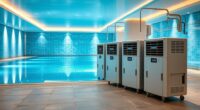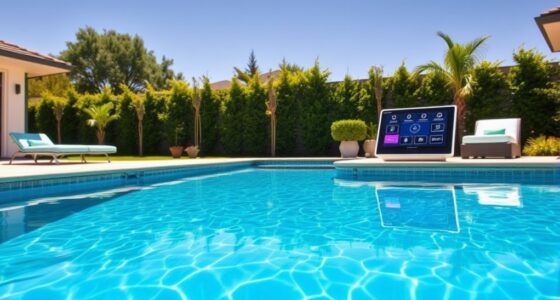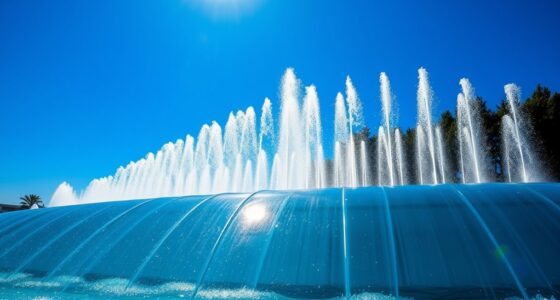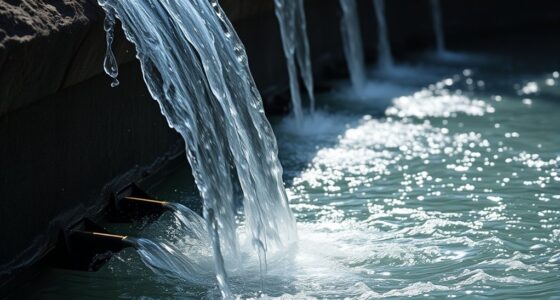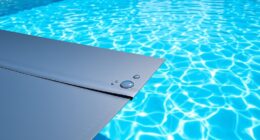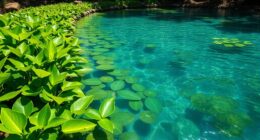Fire and water combos create stunning visual effects that captivate audiences, but they rely on precise planning. You must coordinate timing carefully, synchronize cues, and manage environmental factors like wind and humidity. Advanced equipment, sensors, and safety measures are essential to keep everything safe and seamless. Behind these dazzling displays are hidden logistics and technology working nonstop. If you want to see how this all comes together, keep exploring the details that make these shows so memorable.
Key Takeaways
- Achieving stunning fire and water effects requires precise synchronization of equipment, cues, and environmental monitoring.
- Advanced safety protocols and equipment control systems ensure secure, flawless performances during complex displays.
- Proper planning, rehearsals, and communication are vital to coordinate timing and prevent visual disruptions.
- Environmental factors like wind and humidity significantly influence timing, requiring real-time adjustments.
- Sustainable practices, including resource management and eco-friendly materials, support responsible and reliable shows.
The Art of Designing Fire and Water Displays
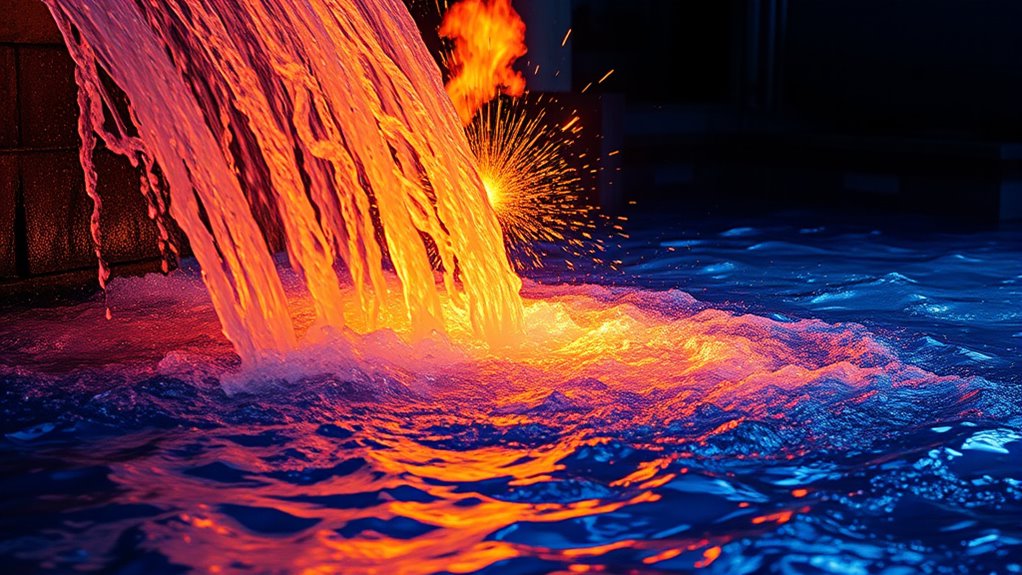
Designing fire and water displays requires a careful balance of elements to create an enthralling experience. You start by understanding how each element interacts, ensuring the fire’s intensity complements the water’s fluidity. Visual aesthetics matter—think about color schemes, shapes, and movement to craft a captivating scene. You’ll need to contemplate the display’s rhythm, blending sparks and spray to keep viewers engaged. Precision in placement is critical; fiery jets should harmonize with water features without overpowering them. You also focus on scale, making sure the display fits the environment and audience size. Mastering these design principles allows you to craft dynamic, mesmerizing shows that captivate while maintaining a seamless integration of fire’s warmth and water’s coolness. Additionally, selecting appropriate fire and water feature equipment ensures safety, efficiency, and visual impact, allowing your display to operate smoothly and impressively.
Safety Protocols and Risk Management
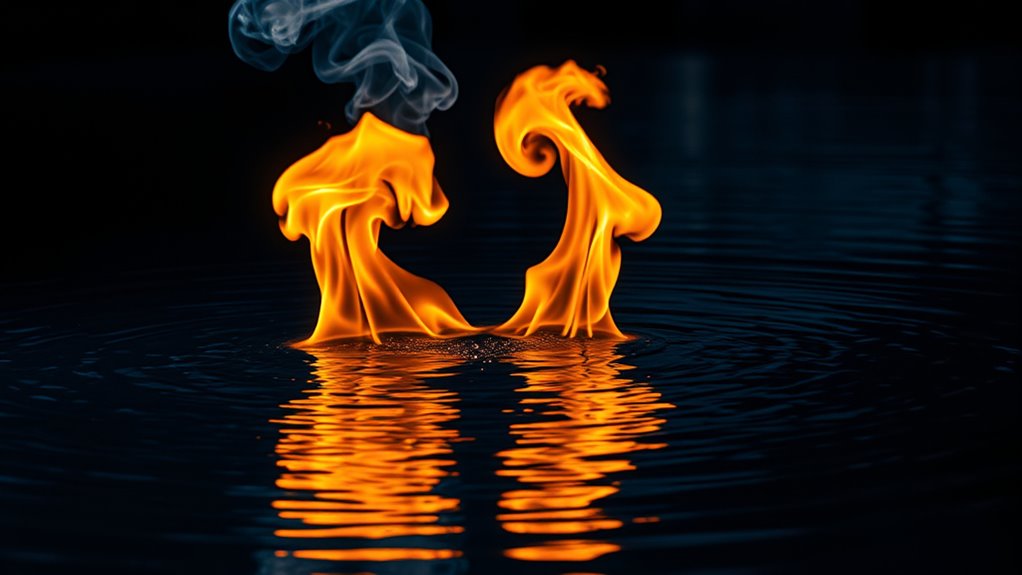
Because fire and water displays involve inherent risks, implementing strict safety protocols is essential to protect both performers and viewers. You must establish clear procedures, including hazard assessments, emergency plans, and safety zones. Training your team thoroughly ensures everyone knows their roles in case of accidents. Regular inspections of equipment and fire-retardant materials help prevent mishaps. Visualize safety zones like this:
| Safe Zone | Danger Zone | Emergency Exit |
|---|---|---|
| Clear, marked areas | Active flames/water jets | Accessible routes |
| Fire extinguishers | Unsupervised equipment | First aid stations |
| Barriers for viewers | Slippery surfaces | Evacuation paths |
Implementing fire-retardant materials and ensuring proper ventilation further minimizes the risk of accidents, creating a safer environment for everyone involved.
Equipment and Technology Behind the Spectacle
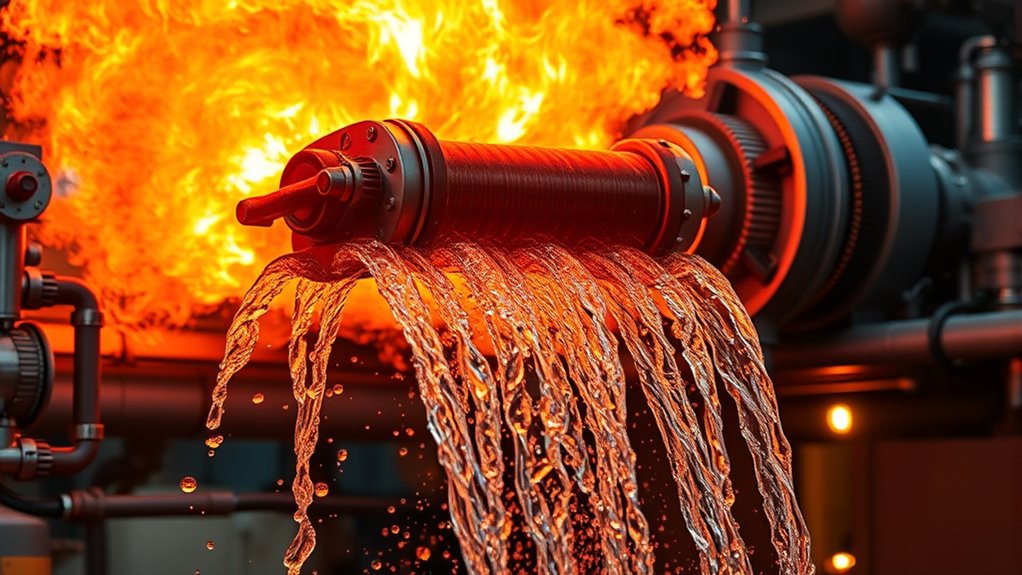
You’ll want to understand the fire propulsion systems that power these displays, along with the water delivery mechanisms that create stunning effects. Safety and control technology guarantee everything runs smoothly and securely. Together, these tools make the spectacle both impressive and safe for everyone involved. Additionally, implementing advanced fraud detection techniques can help ensure secure transactions associated with event ticketing and merchandise sales.
Fire Propulsion Systems
Fire propulsion systems are the engines behind some of the most spectacular water-based displays, harnessing controlled explosions and intense heat to create stunning visual effects. These systems use specialized fuels and combustion chambers designed for rapid ignition and powerful thrust. You’ll find them integrated into pyrotechnic devices, where precise timing ensures safety and spectacular results. They operate with high-pressure gases that propel fire and flames into the air, often synchronized with water jets for maximum impact. Advanced safety measures, like automatic shutdowns and remote controls, keep operators safe while delivering reliable performance. The technology combines engineering finesse with explosive energy, transforming raw power into mesmerizing visual displays that captivate audiences and elevate water shows to a new level of spectacle. Additionally, modern fire propulsion systems often incorporate environmentally friendly fuels and emissions controls to reduce their ecological footprint.
Water Delivery Mechanisms
Water delivery mechanisms are the essential components that bring explosive fire displays to life by precisely directing water jets into the air. You’ll find high-pressure pumps that generate the force needed to shoot water at incredible heights. Specialized nozzles control the shape and direction of each jet, allowing for intricate patterns and effects. Automated control systems synchronize water flow with music or choreography, ensuring seamless performance. Ductwork and piping carry water from reservoirs to the nozzles, maintaining consistent pressure. Some setups employ multi-jet arrays for complex visuals, while others use variable-speed pumps to adjust jet height dynamically. Incorporating advanced water pump technology enhances the efficiency and precision of the display, allowing for more dynamic and spectacular effects. This combination of equipment and technology transforms simple water streams into mesmerizing displays, creating the stunning visual impact audiences expect from water and fire combos.
Safety and Control Tech
Effective control and safety measures are essential to guarantee that water and fire displays run smoothly and securely. You rely on advanced sensors, automated shut-off systems, and remote control panels to monitor conditions in real-time. Fire suppression systems, like foam or mist sprays, activate instantly if unsafe levels are detected. Water flow regulators and pressure sensors ensure precise delivery, preventing overflows or bursts. Video surveillance and alarm systems provide continuous oversight, alerting operators to potential issues before they escalate. Safety barriers and designated exclusion zones keep spectators at a safe distance. By integrating these technologies, you minimize risks, maintain control, and ensure a spectacular show that’s both breathtaking and secure for everyone involved. Real-time monitoring is crucial for promptly responding to unexpected situations and maintaining overall safety.
Coordination and Timing for Seamless Execution
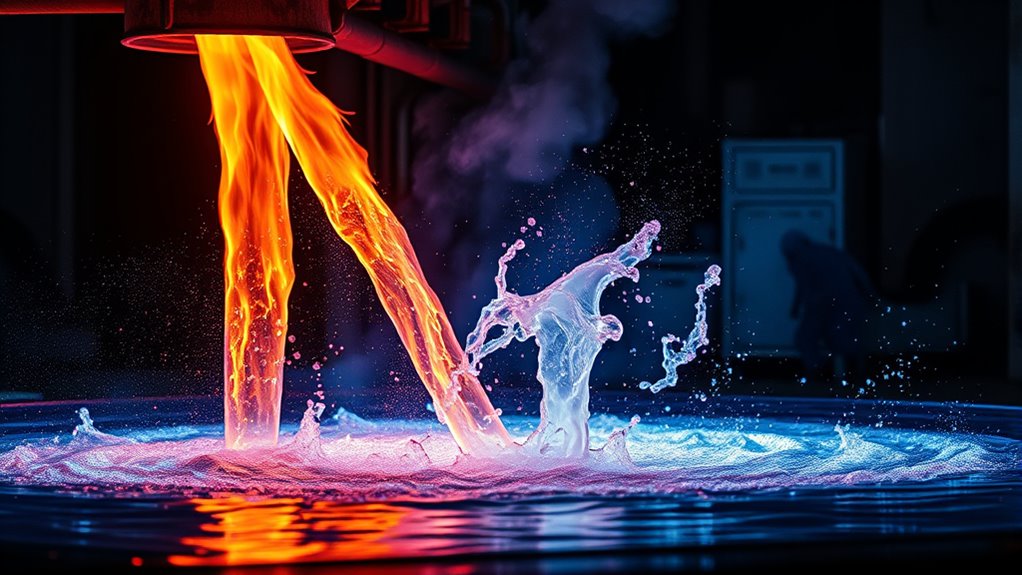
To create a stunning fire and water display, you need to synchronize both elements perfectly. Using precise timing strategies guarantees they complement each other rather than clash. By mastering these coordination techniques, you’ll deliver a seamless and mesmerizing experience for your audience. Proper ventilation considerations are essential to ensure safety and optimal performance of your setup.
Synchronizing Fire and Water
Achieving perfect harmony between fire and water requires careful coordination and precise timing. You need to guarantee both elements activate in tandem to create a seamless display. Timing errors can lead to safety issues or ruined effects. To help visualize this, consider the table below:
| Step | Fire Activation | Water Activation |
|---|---|---|
| Preparation | Set ignition system | Position water jets |
| Trigger | Fire ignites instantly | Water begins flowing |
| Synchronization | Fire peaks at right moment | Water peaks simultaneously |
| Adjustment | Fine-tune ignition timing | Adjust water flow |
| Final Execution | Confirm flawless sync | Confirm harmony |
This coordination ensures the spectacle flows smoothly, mesmerizing your audience without mishaps. Proper synchronization is crucial for safety and visual impact, making timing and coordination essential components of any fire and water display.
Precise Timing Strategies
Precise timing is vital for ensuring fire and water elements work together seamlessly. You need to plan every movement carefully, coordinating the activation of each element to avoid mishaps. Use synchronized cues, like signals or timers, to trigger both fire displays and water effects simultaneously. Practice runs are essential; they help identify timing glitches before the actual event. Maintain clear communication among your team so everyone knows their cues and can respond instantly. Consider environmental factors, such as wind or humidity, which might affect timing. By establishing a detailed schedule and sticking to it, you guarantee a flawless performance. Remember, even a slight delay or premature activation can disrupt the visual harmony, so precise timing is your best tool for a stunning, synchronized show.
Environmental Considerations and Sustainability
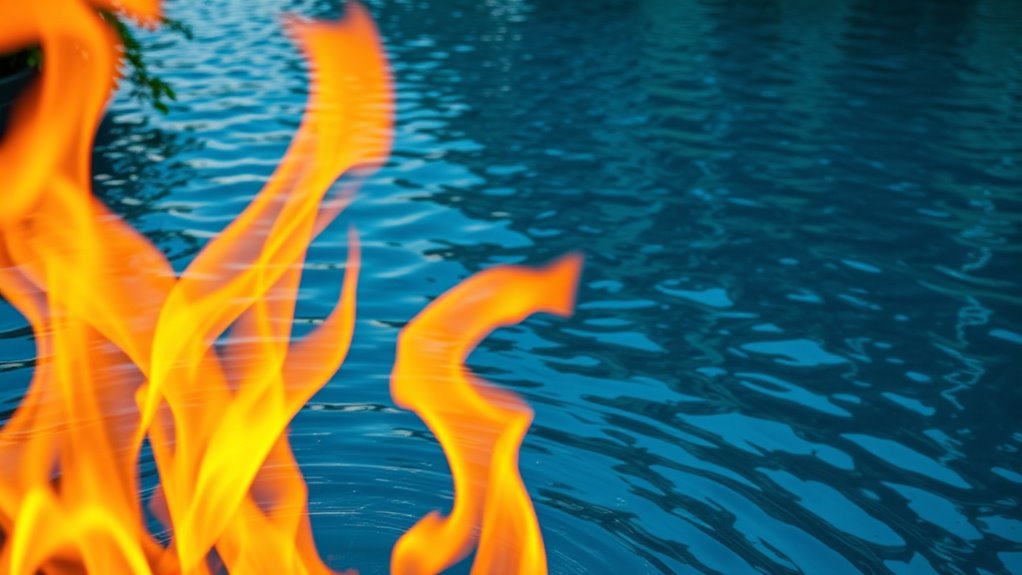
Considering the environmental impact of fire and water combinations is essential for sustainable practices. You should evaluate how these displays affect local ecosystems and resources. To minimize environmental harm, focus on:
- Using eco-friendly fuels and water sources to reduce pollution and water waste.
- Implementing efficient systems that conserve energy and optimize water use during setups and cleanups.
- Choosing materials that are biodegradable or recyclable, ensuring minimal waste after events.
- Being aware of forsale 100 options to source sustainable supplies and reduce overall ecological footprint.
Case Studies: Memorable Fire and Water Shows
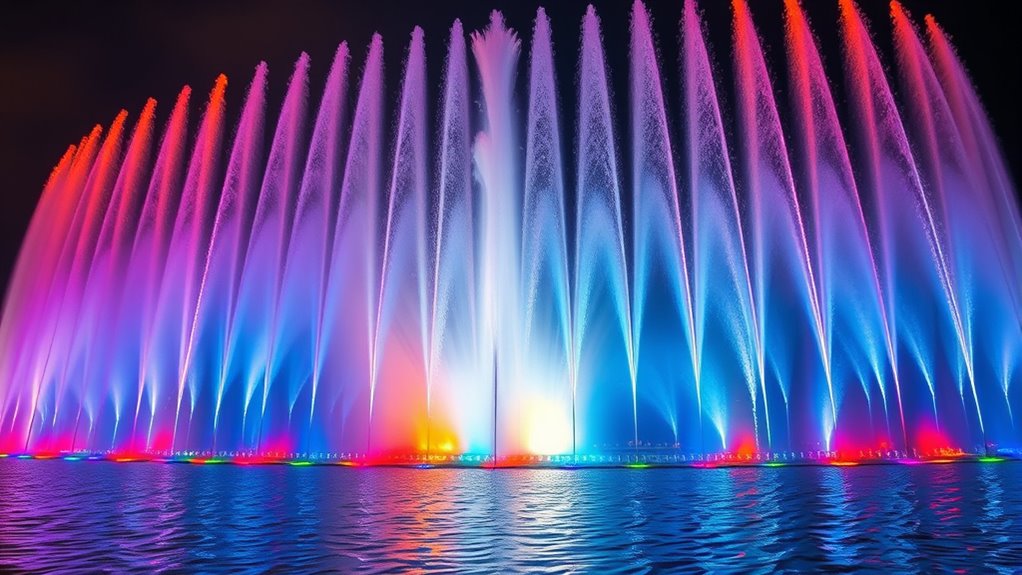
Have you ever witnessed a fire and water show that left you in awe? These performances captivate audiences with their stunning visuals and precise coordination. The 2018 Dubai Fountain show, for example, combined powerful water jets with synchronized flames, creating a mesmerizing display. Another memorable event is the Burning Man festival’s fire and water installations, which blend art and engineering seamlessly. Here’s a quick overview:
| Show | Key Elements | Impact |
|---|---|---|
| Dubai Fountain | Laser lights, synchronized flames | Spectacle, tourism boost |
| Burning Man Installations | Artistic fire-water combos | Cultural significance |
| Harbin Ice Festival | Fire displays over icy water | Unique seasonal attraction |
| Sydney New Year’s Eve | Fireworks, water jets | Global recognition |
| La Tomatina Fire Show | Fire effects, water sprays | Festival excitement |
Frequently Asked Questions
How Do Designers Choose Color Combinations for Fire and Water Displays?
You choose color combinations for fire and water displays by considering their visual impact and emotional resonance. You analyze how warm tones like reds and oranges contrast with cool blues and whites to create striking effects. You also think about the event’s theme and audience preferences, ensuring the colors enhance the overall atmosphere. By experimenting with different hues and intensities, you craft a harmonious yet enthralling display that captures attention.
What Are the Most Common Unexpected Technical Failures During Shows?
Unexpected technical failures during shows often include equipment malfunctions, like faulty ignition systems or water pump failures. You might also face issues with synchronization, causing flames or water jets to misfire or lag. Power outages or electrical surges can abruptly halt the spectacle. These surprises challenge your planning, but quick troubleshooting and backup systems help you maintain control and assure the show goes on smoothly, dazzling your audience despite setbacks.
How Do Organizers Coordinate Multiple Teams During Complex Performances?
You coordinate multiple teams by establishing clear communication channels and detailed schedules. You assign specific roles and use walkie-talkies or headsets for real-time updates. You hold pre-show briefings to clarify responsibilities and troubleshoot potential issues. During the performance, you monitor progress constantly, ensuring teams stay synchronized. By fostering collaboration and quick problem-solving, you keep complex performances running smoothly, creating a seamless experience for your audience.
What Environmental Regulations Impact Fire and Water Display Planning?
You need to comply with local environmental regulations that control water use, waste disposal, and chemical handling. Guarantee your fire and water displays meet safety standards and avoid pollution by using eco-friendly materials. Obtain necessary permits, monitor water runoff, and manage chemical storage carefully. Staying informed about regional laws helps you prevent fines and environmental harm, ensuring your performance is both spectacular and sustainable.
How Are Audience Safety Zones Established and Maintained?
You set safety zones by carefully calculating clear, controlled distances around fire and water displays, considering potential splashes or sparks. You maintain these zones by monitoring crowd movement, using barriers, and employing trained personnel to make certain spectators stay within safe boundaries. Regularly inspecting equipment and adjusting spaces as needed guarantees safety. Staying vigilant and vigilant helps prevent accidents, protecting your audience and ensuring everyone enjoys the spectacle safely and securely.
Conclusion
As you immerse yourself in the world of fire and water displays, remember that behind every dazzling splash and fiery blaze lies a delicate dance of precision and passion. With careful planning and respect for safety, you become the conductor of a mesmerizing symphony that captivates hearts and ignites imaginations. So, embrace the artistry, honor the hidden logistics, and let your creativity ignite a stunning spectacle that leaves everyone breathless, like a fireworks finale lighting up the night sky.

